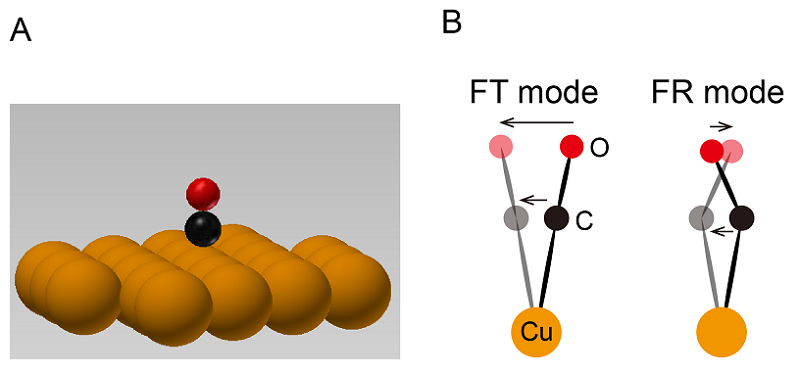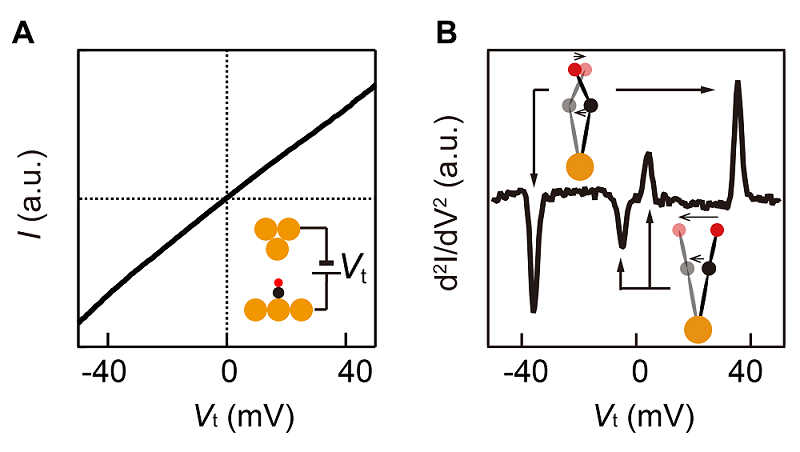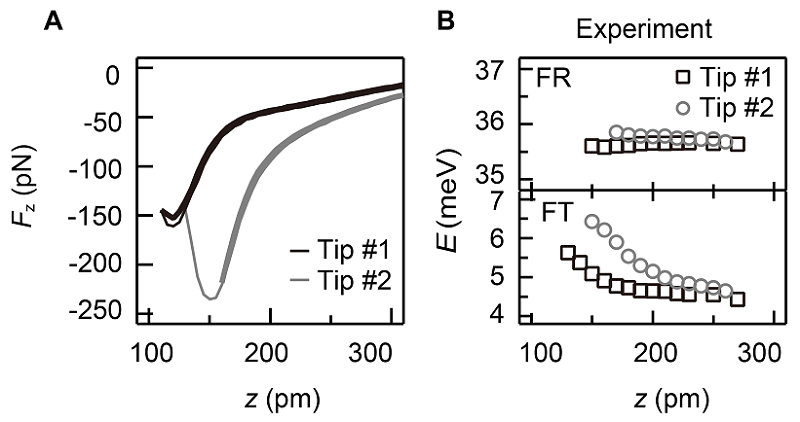Abstract:
The vibration of a molecule on a surface contains critical information on the molecule-surface interaction, crucial for understanding surface phenomena and for important processes like catalysis. It was previously investigated with a scanning probe microscopy, but the probe tip appeared to exert a force on the molecule, affecting the vibration. Here, by combining STM, AFM and model calculations, the experimental results were precisely reproduced; the molecule-surface interactions were weakened by the probe tip proximity.
[Background]
A molecule adsorbed on a surface (Figure 1A) vibrates on the surface (Figure 1B). The vibration energy is determined by the mass of the molecule and by the restoring forces exerted on the molecule. The restoring force originates from the interaction within the molecule and with the surface. By measuring the vibration energy, therefore, we are able to learn details of the interaction of a molecule and a surface. This knowledge is useful in understanding important processes in applied sciences like catalytic reactions*1) that take place on a surface.
Since the vibration energy of a molecule depends to a large extent on the environment of the molecule, it is necessary to measure the vibration energy of an individual molecule to obtain a deep understanding of the interaction of a molecule and a surface, taking into account the environment. For example, a single molecule in isolation on a single crystal surface as shown in Figure 1A is an ideal target of this type of research.
The vibration energy of a single molecule can be investigated, with a scanning tunneling microscope (STM)*2), by placing the metal probe of STM right above the molecule and by precisely measuring the current by changing the voltage applied between the probe of STM and the surface. As shown in Figure 2A, the current (I ) and the voltage (V) show an approximately linear relationship, the second derivative of which (V derivative of dI /dV) shows a peak and trough pair as shown in Figure 2B. The peak and trough pair corresponds to the vibration energy of a molecule. Thus, using this method, the vibration energy of a single molecule can be determined.
It was previously reported, however, that when a metal probe was placed very close to a molecule in order to measure the current, the probe tip itself exerted a force on the molecule, affecting its vibration energy. In this study, we have measured the force between the probe and the molecule by atomic force microscope (AFM)*4) and the vibration energy by STM to elucidate their relationship.
[Results]
The present study was conducted by a collaboration of researchers from Kanazawa University, Japan, University of Regensburg, Germany, and Linnaeus University, Sweden. The experiments were done at University of Regensburg.
The force between a probe and a molecule was measured by using the force sensor developed by Prof. Giessibl, University of Regensburg, Germany, a coauthor of the study. The support that was attached with the force sensor was oscillated at a resonance frequency (about 50 kHz) of the cantilever of the sensor to oscillate the cantilever effectively. A metal probe was attached at the tip of the cantilever, where the probe tip consisted of just one atom. By placing the probe tip in close proximity of a molecule adsorbed on the surface, a force arises between the molecule and the probe tip, which changes the resonance frequency of the cantilever. From such changes, the force between the probe tip and the molecule can be determined. Figure 3A shows the experimental data concerning the force arising between the probe tip and CO molecule adsorbed on a copper surface upon changing the distance between the probe tip and CO molecule; one set of data is compared with another set with a different probe tip. This comparison indicates the difference in the forces exerted on the molecule by the two different probe tips. Each probe tip consists of just one atom, but the difference in the structure behind the single atom affects the forces exerted.
After the force measurements, the vibration energy was investigated by precisely measuring the current that was generated by applying a voltage between the probe tip and the surface. Figure 3B shows the change of the vibration energy upon changing the distance between the probe tip and the molecule. The probe tip that exerts the larger attracting force affects the vibration energy of the molecule to a greater extent.
Next, the experimental results were analyzed using a classical model that considers the vibration of a molecule as a double pendulum. With an ordinary pendulum, gravity provides a restoring force, while in this study, the bonds within the molecule and between the molecule and the surface provided a restoring force. The vibration energy was calculated using this pendulum model with forces arising between the probe tip and the molecule taken into consideration. In addition, it was also taken into consideration that the forces exerted by the probe tip weakened the bonds within the molecule and between the molecule and the surface. This model successfully and precisely reproduced the experimental results.
[Future prospects]
The present study significantly deepens our understanding of the interaction of a molecule and a surface and of the interaction of a probe tip and a molecule. In this study, a simple molecule, CO, having a very simple molecular structure has been employed as a target of research. It is expected that this study will stimulate further investigation of molecules of more complicated structure and technological importance. It is also expected that the bond between a molecule and a surface would be severed by a metal probe tip, which may be applied to processes inducing chemical reactions.

Figure 1
A. Schematic image of a single CO molecule in solitude adsorbed on a single copper crystal. B. Schematic images of vibrations of a CO molecule adsorbed on a copper surface. A CO molecule on a surface exhibits two types of horizontal vibrational modes. The low energy mode of vibration is called the Frustrated Translational (FT) mode, where the oxygen and carbon atoms deflect in the same direction. The high energy mode of vibration is called the Frustrated Rotational (FR) mode, where the oxygen and carbon atoms deflect in the opposite directions.

Figure 2. Vibrational spectroscopy using scanning tunneling microscope.
A. Upon application of voltage between a metal probe of a scanning probe microscope*3) and a copper surface on which the molecule is adsorbed, an electric current is generated between the two electrodes. The relationship of the current (I ) and voltage (Vt) is approximately linear. B. The second derivative of the relationship of the current and the voltage gives two pairs of peaks and troughs at the voltage corresponding to the vibration energy of the molecule. One pair represents the FT mode, the other, FR mode.

Figure 3. Effects of the force generated between a metal probe and a molecule on the vibration energy.
A. The force (Fz) generated on both upon changing the distance (z) between the probe tip and the molecule. Minus sign means attractive force generated. The figure shows experimental results with two different probes, indicating the force is different with a different probe. B. The vibration energy (E) of CO molecule upon changing the distance between the probe and the molecule. The probe exerting a bigger force on the molecule brings about a larger change in the vibration energy of the molecule.
[Glossary]
*1) Catalytic reaction
A catalyst is a substance that accelerates a chemical reaction without itself changing during the reaction, and a chemical reaction facilitated by a catalyst is called a catalytic reaction. For example, reaction of CO, toxic substance produced and released by a car, with oxygen to produce much less hazardous carbon dioxide is accelerated by a metal surface as a catalyst.
*2) Scanning tunneling microscope
A microscope to visualize surface unevenness by detecting a very weak electric current between a sharp metal probe and a surface (the current arising by quantum effects, called the tunneling current).
*3) Scanning probe microscope
General term for scanning tunneling microscope and atomic force microscope. The specimen is traced by a micro-needle (probe) to reveal the structure and characteristics of the specimen.
*4) Atomic force microscope
A microscope to visualize surface unevenness by measuring the force arising between a sharp metal probe and a surface.
Article
Vibrations of a molecule in an external force field
Journal: Proceedings of the National Academy of Sciences of the United States of America
Authors: Norio Okabayashi, Angelo Pronio, Magnus Paulsson, Toyoko Arai, Franz J. Giessibl
Doi: 10.1073/pnas.1721498115
Funders
Deutsche Forschungsgemeinschaft grants SFB 689 and GRK 1570; JSPS KAKENHI grants JP25790055, JP16K04959, and JP16KK0096; JSPS grant Strategic Young Researcher Overseas Visits Program for Accelerating Brain Circulation; Kanazawa University SAKIGAKE Project.



 PAGE TOP
PAGE TOP